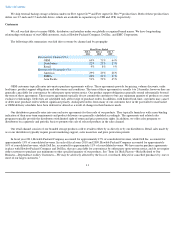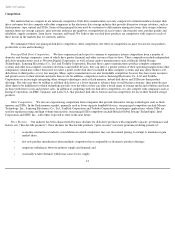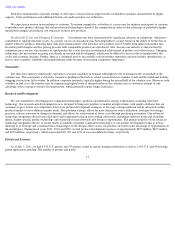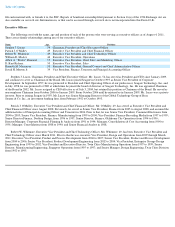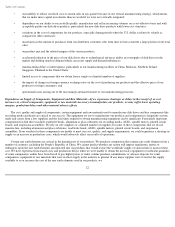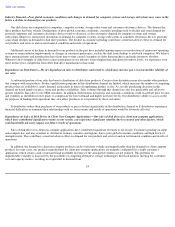Seagate 2010 Annual Report Download - page 23
Download and view the complete annual report
Please find page 23 of the 2010 Seagate annual report below. You can navigate through the pages in the report by either clicking on the pages listed below, or by using the keyword search tool below to find specific information within the annual report.
Table of Contents
• competitive pressures resulting in lower selling prices by our competitors targeted to encourage shifting of customer demand;
•
delays or problems in our introduction of new products, particularly new disk drives with lower cost structures, the inability to
achieve high production yields or delays in customer qualification or initial product quality issues;
• changes in purchasing patterns by our distributor customers;
•
increased costs or adverse changes in availability of supplies of raw materials or components;
•
the impact of corporate restructuring activities that we have and may continue to engage in;
•
changes in the demand for the computer systems, storage subsystems and consumer electronics that contain our disk drives, due to
seasonality, economic conditions and other factors;
•
changes in purchases from period to period by our primary customers, particularly as our competitors are able to introduce and
produce in volume competing disk drive solutions or alternative storage technology solutions, such as flash memory or SSDs;
• shifting trends in customer demand which, when combined with overproduction of particular products, particularly when the
industry is served by multiple suppliers, results in unfavorable supply/demand imbalances;
• our high proportion of fixed costs, including research and development expenses;
• announcements of new products, services or technological innovations by us or our competitors; and
•
adverse changes in the performance of our products.
As a result, we believe that quarter-to-quarter comparisons of our revenue and results of operations may not be meaningful, and that these
comparisons may not be an accurate indicator of our future performance. Our results of operations in one or more future quarters may fail to
meet the expectations of investment research analysts or investors, which could cause an immediate and significant decline in the trading price of
our ordinary shares.
New Product Offerings
—Market acceptance of new product introductions cannot be accurately predicted, and our results of operations will
suffer if there is less demand for our new products than is anticipated.
We are continually developing new products with the goal that we will be able to introduce technologically advanced and lower cost disk
drives into the marketplace ahead of our competitors.
The success of our new product introductions is dependent on a number of factors, including market acceptance, our ability to manage the
risks associated with product transitions, the effective management of inventory levels in line with anticipated product demand and the risk that
our new products will have quality problems or other defects in the early stages of introduction that were not anticipated in the design of those
products. Accordingly, we cannot accurately determine the ultimate effect that our new products will have on our results of operations.
In addition, the success of our new product introductions is dependent upon our ability to qualify as a primary source of supply with our
OEM customers. In order for our products to be considered by our customers for qualification, we must be among the leaders in time-to-market
with those new products. Once a product is accepted for qualification testing, any failure or delay in the qualification process or a requirement
that we requalify can result in our losing sales to that customer until new products are introduced. The limited number of high-volume OEMs
magnifies the effect of missing a product qualification opportunity. These risks are further magnified because we expect competitive pressures to
result in declining sales, eroding prices, and declining gross margins on our current generation products.
20



